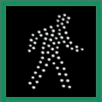 Sweden is on its way to reaching zero road deaths per year. The Economist earlier this year took a look at the data: just three deaths per 100,000 people, compared to 5.5 in the European Union and 11.4 in the US. (See this European Commission report for additional data.)
Sweden is on its way to reaching zero road deaths per year. The Economist earlier this year took a look at the data: just three deaths per 100,000 people, compared to 5.5 in the European Union and 11.4 in the US. (See this European Commission report for additional data.)
How has Sweden done it? “We are going much more for engineering than enforcement,” Matts-Åke Belin, a government traffic safety strategist told Citylab. We wonder whether New York city will adopt the same strategy?
A good step in that direction would be the Protected-Only Phase Signal: It prevents turning vehicles from hurting or killing pedestrians who cross in the pedestrian crossing with the Walk sign. Today 44% of pedestrians hospitalizations are due to crashes under those circumstances.
In Manhattan, PROPS installations have decreased injury crashes by 50% (9th Avenue Bike lane in Chelsea) to 63% , on 7th Avenue and 23rd Street intersection. But In Hell’s Kitchen, it took two deaths and 7 years to install a PROPS at 41 st street and 9th Avenue, and the bike lanes above 34th street were not equipped with PROPS.
The federal Highway safety manual recommends to install PROPS wherever there is an insufficient level of safety for pedestrians. So, in the era of Vision Zero, if the solution exists to address such a large and devastating issue, what do we need to do to accelerate the installation of such a device at every dangerous intersection?
The forgiving roadway:
According to the Federal Highway safety manual, in the past, when human errors resulted in collisions, the fault was perceived to lie with the road user, rather than with the road. The approach to roadway safety has since evolved. While the concept of “road user error” remains, it is now understood that errors and the collisions that result do not just “happen,” they are “caused,” and the roadway environment sometimes plays a role in that causation. The forgiving roadway seeks to break the chain of causation between the erroneous decisions and/or actions and their undesirable outcomes (e.g., crashes). The forgiving roadway concept is fundamental to ‘Vision Zero’ as the Swedes have demonstrated, and is predicated on meeting the expectations of road users— motorists, bicyclists, and pedestrians—and assuring that they get needed information when it is required, in an explicit and usable format and in sufficient time to react.
Road users who are not visually impaired receive most of their information visually. The human visual field is large; however, the area of accurate vision is quite small. Complex or cluttered backgrounds, make individual pieces of information more difficult to identify and can make the driving task more difficult.. This is of particular concern in areas of high workload, at decision points, and at locations where there is a high potential for conflict Intersections and crosswalks in Manhattan squarely fall in that category.
To reduce road users errors at signalized intersections the information must reinforce their expectations. Road users will rely on experience rather than their perceptions (however incomplete) of the situation at hand when their expectations are not met. When turning with the green light, the user expectation is that he/she has the right of way. For a driver who is about to make a left or right turn, a green light provides incomplete information , that leads to false expectations (that the driver has priority and no obstruction) and thus provides insufficient time for decision (stop).
The best way to address this issue is to install PROPS :the green light gives an unequivocal right of way to drivers as they expect and the walk signal gives an unequivocal right of way to pedestrians as expected. Protected-only Phasing Signal consists of providing a separate phase for turning traffic and allowing turns to be made only on a green left arrow signal indication, with no pedestrian movement or vehicular traffic conflicting with the turn.

A counter intuitive benefit of these treatments is that left-turn movements with protected-only phasing have a higher capacity than those with permissive-only phasing which are more dangerous due to fewer conflicts. These are the signals installed at most two way streets intersections.
So why are such signals not ubiquitous?
Three key engineering manuals recommend the use of protected-only operations except when, based on engineering judgment, an unacceptable reduction in [vehicular] capacity will result.[2] [3] . The manuals put the final decision squarely in the hands of the engineers and based only on a vehicle capacity measurement. In New York City, where the capacity is never enough, the decision has been a given.
Unacceptable to whom? Capacity in terms of vehicles or in terms of pedestrians? And why should the engineer make the decision? Unacceptable reduction in capacity and engineering judgement are inadequate yardsticks to decide life and deaths issues. The Departement of Transportations and the elected officials must use the Vision Zero framework to establish two new criteria: Unacceptable level of pedestrian capacity and unacceptable level of pedestrian safety.
Fortunately, their are indicators that the tide is changing: at the Vision Zero Symposium in late 2014, Ydanis Rodriguez, Chair of City Council Transportation Committee advocated for the installation of PROPS as the assembly applauded! This should encourage us to raise the bar and insist on safe intersections to reduce hospitalizations by 44%.
References
1 http://safety.fhwa.dot.gov/intersection/signalized/13027/ch2.pdf.
2 ICG4, ITE:4, MUTCD:4
Credit to http://www.fhwa.dot.gov/publications/research/safety/humanfac/01103/
